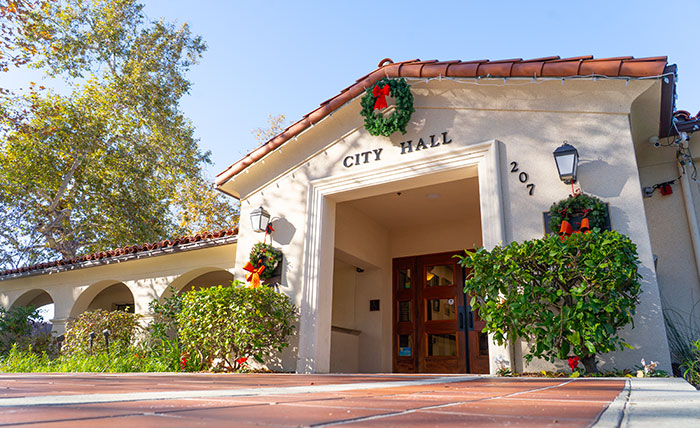Staff bonuses, new community services director hired
The city took advantage of an unexpected general fund surplus by giving bonuses to city employees.
A total of 143 employees will be receiving a one-time bonus of $718, according to Finance Director Adam Pirrie.
General fund expenditures for the year totaled $26,002,503, not including settlement payments to Golden State Water Company, general liability and workers compensation, medical insurance and subsidies, Measure SC election expenses and roof repairs to city hall and the Joslyn Senior Center.
Revenues for the year topped out at $26,210,852, which includes property and sales taxes. Property taxes for the year were approximately $330,000 higher than initial estimates, the city said, and sales tax revenues were $276,000 above what the city initially budgeted.
The property tax surge was due to larger and expected growth in assessed values for Claremont homes, the city noted. For sales tax, the city cited the recent addition of retail and restaurant businesses, as well as more car sales and a generally improved economy.
All told, the overall budget surplus totaled $208,349, Mr. Pirrie said.
Half of that amount will be going into the city’s operational and environmental emergency reserve, the city said. But the other half will be distributed to city employees as a one-time $718 bonus, Mr. Pirrie said.
This is because of language in the employee memoranda of understanding (MOU), which stipulates that city employees receive half of any available budget surplus as a one-time bonus of up to $1,000, the city said.
The MOUs were approved by the city in July after weeks of negotiations with city management and representatives of various employee groups.
Initially, the city employees were set to receive a $566 bonus, due to benefit costs from PERS and Medicare. But Mr. Pirrie told the council at last Tuesday’s meeting that the city had just found out the bonuses would not be subject to PERS costs.
The remaining surplus will be directed to Claremont’s operational and environmental emergency reserve, which will increase that balance to $5,648,217, or around 22 percent of the general fund, but still below the city’s goal of 25 percent, the city said.
The council unanimously approved the budget surplus and staff bonuses.
“I think this is good news for the employees,” Mayor Opanyi Nasiali said. “They get to take home a little more than they were going to get so far.”
New community services director introduced
Chris Paulson was officially introduced as Claremont’s new community services director at last Tuesday’s meeting.
Mr. Paulson comes to Claremont from Alhambra, where he was the director of the city’s parks and recreation department. He started his city career as an intern in the Alhambra city manager’s office and moved up from there, becoming an administrative analyst in 2009, assistant to the city manager in 2012, and the director of administrative services in 2014.
City Manager Tara Schultz, herself a former Alhambra city employee, introduced Mr. Paulson to the council. Ms. Schultz was Alhambra’s assistant city manager before starting in Claremont in February.
As the assistant to the city manager, Mr. Paulson worked on solid waste and recycling contracts, energy conservation programs, sustainability projects and expanded the city’s code enforcement, Ms. Schultz said. As director of administrative services, Mr. Paulson oversaw the building maintenance division and the IT department.
Mr. Paulson told the council that he was excited to be a part of Claremont.
“Your city, your community is absolutely beautiful,” he said. “It’s a great community, and I’m really excited to make sure that I maintain the beauty and integrity of this community through the community services department.”
Mr. Paulson started his job on November 5. He replaces Roger Bradley, who left the city in July to take a job in Kings County as their assistant county manager.
Electric vehicle ordinance extended
The council also unanimously approved an amendment to remove the sunset date to an ordinance regulating electric vehicle parking spaces in the city.
The ordinance was originally approved in January 2015 with a sunset date of December 31, 2018 in case technology moved beyond the need for parking spaces where EVs can charge, according to Community Development Director Brad Johnson in his presentation to the council.
Since then, the spaces have proved to be popular, and the need for EV and zero-emission cars has expanded, culminating with a state mandate to have five million zero-emission cars on California roads by 2030.
The ordinance also gives the city engineer flexibility to put in more EV spaces around the city if needed. There are currently four EV charging spaces in the Claremont Village behind city hall.
Mr. Johnson said over 60 citations have been issued by the police department to non-EV cars parked in those spaces since the ordinance was established, and two citations given to EV cars that were in the spot longer than the three-hour time limit.
This prompted Mayor Pro Tem Corey Calaycay to request that language be added to EV parking signs to remind drivers that the same three-hour parking rules apply to them as well.
“Just to be fair, so they also understand that,” Mr. Calaycay said.
Ms. Schultz noted that the city could do that. The council unanimously passed the item, 5-0
The next city council meeting will take place on November 27.
—Matthew Bramlett
news@claremont-courier.com










0 Comments